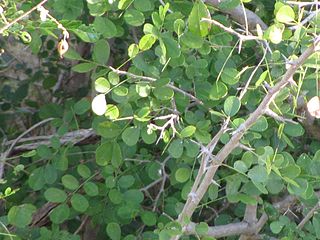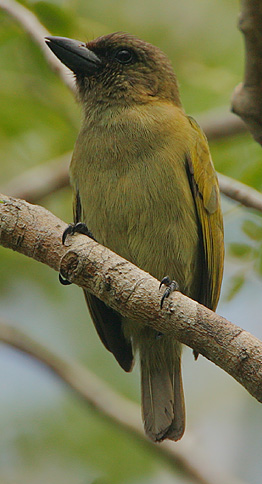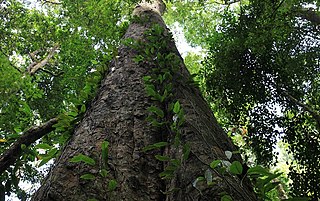
Dalbergia melanoxylon in french Granadille d'Afrique is a flowering plant in the family Fabaceae, native to seasonally dry regions of Africa from Senegal east to Eritrea and south to the north-eastern parts of South Africa. The tree is an important timber species in its native areas; it is used in the manufacture of musical instruments and fine furniture. Populations and genomic resources for genetic biodiversity maintenance in parts of its native range are threatened by overharvesting due to poor or absent conservation planning and by the species' low germination rates.

The Sokoke scops owl is a highly localized species of scops owl found in lowland forests of Kenya and Tanzania. The greatest population of this species of owl is in the Cynometra-Manilkara forest, which is less than one-third of the Sokoke Forest. It is also found in the Afzelia-Cynometra forest.
Cynometra lukei is a species of plant in the family Fabaceae. It is found in Kenya and Tanzania and threatened by habitat loss.
Erythrina schliebenii is a species of legume in the family Fabaceae. It is found only in Tanzania. The species is named for German collector and botanist Hans-Joachim Schlieben.

Brachylaena is a genus of flowering plants in the aster, or composite, family, Asteraceae or Compositae. Several are endemic to Madagascar, and the others are distributed in mainland Africa, especially the southern regions.

Allanblackia stuhlmannii is a species of flowering plant in the family Clusiaceae. It is found only in Tanzania.
Ravenea musicalis, or the river palm, is a species of flowering plant in the family Arecaceae. Also known by the Antanosy word "torendriky," meaning "submerged trunk", R. musicalis is known for being the only truly aquatic palm tree. Like many mangrove trees, R. musicalis seeds germinate within the fruit, and the seedling takes root underwater. as much as eight feet below the surface. Endemic to Madagascar, R. musicalis was first discovered in 1993 by Henk Beentje on an expedition funded by the McDonald's restaurant. although of course it was ethnoknown by the Antanosy People for centuries. This palm is listed in the IUCN Red List. This tree is harvested by local people primarily for building material and food. Over-harvesting, habitat degradation and habitat loss threaten the remaining populations. Horticulturalists prize R. musicalis for its rarity and unique life history.

Hildebrandt's starling is a species of starling in the family Sturnidae. It forms a superspecies with and has previously been included in the same species as Shelley's starling, a migratory species ranging from Ethiopia and Somalia to Kenya. Both of these species have also been combined into a superspecies with the chestnut-bellied starling of West Africa. It was originally placed in the now defunct genus Notauges. The species is named for Johann Maria Hildebrandt, a German collector who was the first European to obtain specimens.

The buff-spotted flufftail is a species of bird in the family Sarothruridae. It is found in forested areas of Angola, Botswana, Burundi, Cameroon, Republic of the Congo, Democratic Republic of the Congo, Ivory Coast, Equatorial Guinea, Eswatini, Ethiopia, Gabon, Guinea, Kenya, Liberia, Malawi, Mozambique, Nigeria, Rwanda, Sierra Leone, Somalia, South Africa, South Sudan, Tanzania, Uganda, Zambia, and Zimbabwe.

The little spotted woodpecker or green-backed woodpecker, is a species of bird in the family Picidae. It is native to large parts of tropical central Africa. It has an extensive range and is an uncommon species, and the International Union for Conservation of Nature has rated its conservation status as being of "least concern".

The green barbet is a species of bird in the Lybiidae family. It is found in Kenya, Tanzania, Malawi, Mozambique and South Africa. It occurs in forests from sea level to 1,800 metres (5,900 ft). Its isolated populations are vulnerable to forest clearing.
Warburgia stuhlmannii is a species of plant in the family Canellaceae. The genus is named after Dr Otto Warburg, botanist and lecturer in Berlin. and the species after Franz Stuhlmann, also a renowned botanist who directed the Amani Research Institute and its botanical garden in German East Africa. It is a rare, small, evergreen tree, reaching heights from 12 to 24 metres, and has glossy leaves. It is found in the coastal woodlands and forests of Kenya and Tanzania and is threatened by habitat loss. It is known as mkaa in Swahili.
Ziziphus robertsoniana is a species of plant in the family Rhamnaceae. It is found primarily in Kwale, on the southern coast of Kenya, and may also be found in Tanzania. It is threatened by habitat loss.

The eastern grey woodpecker, also known as grey-headed woodpecker and mountain gray woodpecker, is a species of bird in the woodpecker family Picidae. It is a resident breeder in eastern Africa. It has a large range and is a fairly common species. No special threats have been recognised and the International Union for Conservation of Nature has rated the bird's conservation status as being of "least concern".

Northern Zanzibar–Inhambane coastal forest mosaic, also known as the Northern Swahili coastal forests and woodlands, is a tropical moist broadleaf forest ecoregion of coastal East Africa. The ecoregion includes a variety of habitats, including forest, savanna and swamps.

Maesopsis eminii, the umbrella tree, is a species of tree in the family Rhamnaceae found in India and Africa. It is the only species in the genus Maesopsis. It is often grown as a plantation tree, and as a shade tree in coffee plantations and other crops. Birds and monkeys may disperse the seeds. Since this tree grows fast it is often used for regeneration of destroyed forest lands. Its timber is used for construction and firewood and its leaves for animal fodder.

Klainedoxa gabonensis is a large tropical African tree of the family Irvingiaceae growing to 40m in height. Its straight trunk is buttressed and up to 25m long, while its spreading evergreen crown makes it one of the largest trees of the rainforest. It is found from Senegal to Sudan, Cameroons, Ivory Coast, Democratic Republic of the Congo, Uganda and Tanzania, growing as far south as Angola and Zambia.

Encephalartos kisambo is a species of cycad in the family Zamiaceae. It is native to Kenya and Tanzania. It is known as the Voi cycad.

Entandrophragma excelsum, is Africa's tallest indigenous tree native to tropical East Africa and occurs in eastern D.R.of the Congo, Rwanda, Burundi, Uganda, Tanzania, Malawi and Zambia. This species is scattered in areas of upland semi-deciduous forest, in mid-elevation and montane rainforest, at 1280 – 2150 metres elevation. It is locally also found in riverine forest.
Cornus volkensii is a species of tree in the family Cornaceae native to montane forests of eastern Africa, from South Sudan and Kenya south to Zimbabwe and Mozambique.















